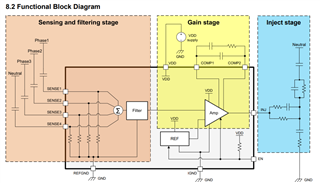Other Parts Discussed in Thread: TPSF12C3
Tool/software:
Dear Specialists,
My customer is interested in TPSF12C3-Q1 and has a question.
I would be grateful if you could advise.
---
(1) Is TPSF12C3 possible to use for high voltage, high current applications as long as the common mode voltage (SENSE1, SENSE2, SENSE3, SENSE4 to REFGND) is within ±5V?
(For example, three-phase square waves of 0V to several hundred V, several hundred Arms)
(2) I think the TPSF12C3 is a voltage detection, current compensation type VSCI.
Does the current actually measure in the detection part of the circuit?
Are the resistors between Sensex and REFGND in the sensing and filtering stage( in the detection part of the datasheet p9 8.2 Functional Block Diagram) a shunt resistor?

ーーー
I appreciate your great help in advance.
Best regards,
Shinichi

